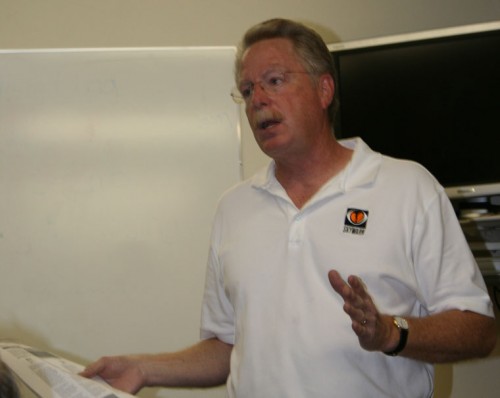
Photo by Marshall Smith
As part of a run up to what is predicted to be a strong El Niño, Mile High Radio Club hosted a presentation about Skywarn – a Department of Commerce, National Oceanic and Atmospheric Administration, National Weather Service program.
Skywarn is a volunteer program with 290,000 trained weather spotters throughout the United States. Volunteers help keep their local communities safe by providing timely and accurate reports of severe weather to the National Weather Service.
At its Thursday, Oct. 8 meeting, Ed Sherman, Riverside County Skywarn Coordinator, talked about the program and how Idyllwild locals could become involved. Sherman, who has more than 40 years experience with public safety, also talked on disaster preparedness, including preparation of emergency plans and obtaining and stocking emergency kits.
Although Skywarn spotters provide information for all types of weather hazards, their main responsibility is to identify and report severe local storms, with particular attention to weather caused hazards, such as flooding, as well as blocked and impassable roadways.
Sherman noted that weather tracking technology is advanced, with improved Doppler radar, satellite and other data. “With all the technology, the missing element is the human being in the field making observations of developing conditions,” he said. “To be involved, you don’t have to have any specific experience, just your interest and your senses.”
Sherman directed those interested to visit the National Weather Service San Diego site to sign up and train by watching a slide presentation on the website and take an online quiz as part of the registration process. Reports of severe weather conditions can then be filed by spotters directly on the site. Skywarn classes are also offered by NOAA’s warning coordination meteorologists. For more information visit, http://www.stormready.noaa.gov/contact.htm.
Ham radio operators can participate in once-a-week practice sessions reporting both operator location and weather observed, said Sherman.
NWS encourages anyone with an interest in public service and access to communication to join Skywarn. Training covers understanding the basics of thunderstorm development, fundamentals of storm structure, identifying potential severe weather features, how to report information and basic severe weather safety.
Sherman noted all volunteers begin as weather spotters, who basically observe and report. “It’s more passive,” he said. “You report from wherever, either on a toll-free number or online. A more active category is a Skywarn member. They may actively look for and determine hazards as weather patterns are developing.”
Sherman stressed how most people underestimate the ability of fast-flowing water to move and transport heavy objects, including cars and trucks, and cautioned that drives should not attempt to cross fast-flowing water courses.
In an average year, there are 10,000 severe thunderstorms, 5,000 floods and more than 1,000 tornadoes across the U.S. that threaten lives and property. Skywarn volunteers help to prevent loss of life in weather emergencies.
For more information contact Bill Tell at www.milehighradioclub.org or Sherman at [email protected] or [email protected].










